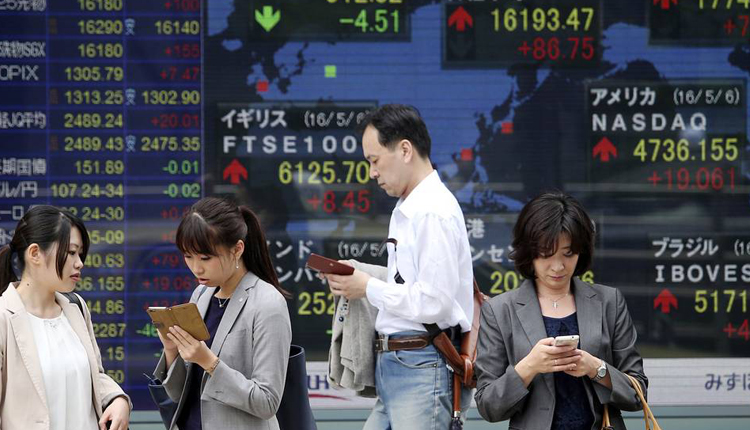Asian stocks were mixed on Monday amid increasing concerns over the state of global trade.
Mainland Chinese shares closed lower, with the Shanghai composite slipping 0.3% to 2,890.08 and the Shenzhen component declining 0.74% to 8,856.99. The Shenzhen composite also shed 1.043% to 1,515.89.
Over in Hong Kong, the Hang Seng index declined 0.15%, as of its final hour of trading. Hong Kong-listed shares of HSBC dropped 1.01%, while life insurer AIA slipped 1.56%.
In Japan, the Nikkei 225 fell 0.92% on the day to 20,410.88 as index heavyweight Fanuc saw its shares drop 3.30%. The Topix index also shed 0.88% to close at 1,498.96. Japanese conglomerate Softbank Group saw its stock plunge 6.22% after the Wall Street Journal reported the company was facing challenges in raising money for its latest fund.
Over in South Korea, the Kospi added 1.28% to close at 2,067.85 as shares of industry heavyweight Samsung Electronics and chipmaker SK Hynix gained 3.06% and 1.99%, respectively.
In Australia, the ASX 200 slipped 1.19% to finish at 6,320.50 as almost all sectors declined.
One strategist described the current environment as “very difficult” and “very tricky.”
“It is time to be thinking about … where can you earn a secure yield. It’s playing defense in equities rather than being aggressive,” Jonathan Garner, managing director and chief Asia and emerging market equity strategist at Morgan Stanley, told CNBC’s “Squawk Box” on Monday.
Data from a private survey on Monday showed that Chinese manufacturing activity was better than expected in May.
The Caixin/Markit factory Purchasing Managers’ Index for May was 50.2, as compared to expectations of 50 by analysts in a Reuters poll. The PMI reading for April was 50.2. PMI readings above 50 indicate expansion, while those below that signal contraction.
Last week, China’s official manufacturing PMI for May came in at 49.4, lower than the 49.9 economists polled by Reuters had forecast. It was also lower than April’s reading of 50.1. The official non-manufacturing PMI for May was 54.3 — unchanged from April.
James Cheo, chief market strategist of Southeast Asia at HSBC Private Banking, told CNBC’s “Capital Connection” that domestic growth, in particular services and auto sales, is “still holding up fairly well.”
“It’s fair to say that the external side, the manufacturing side, it’s a little bit slow. But I think the domestic side is still fairly resilient,” he said.
Stocks on Wall Street took a dive last Friday, as the S&P 500 ended May down 6.6% as volatility spiked after trade talks fell apart with China and rhetoric on both sides worsened in May, while the Dow Jones Industrial Average notched its sixth straight weekly loss — the longest weekly losing streak for the Dow since 2011. The S&P 500 and Nasdaq Composite posted their fourth straight weekly loss. The major indexes also snapped a four-month winning streak.
The losses came as investors digested recent developments on U.S. trade policy, with U.S. President Donald Trump announcing Thursday that America would impose a 5% tariff on all Mexican imports from June 10 until illegal immigration across the southern border was stopped.
That announcement came amid a protracted trade dispute between the U.S. and China, with both sides having slapped billions of dollars of tariffs on each others goods as the conflict hits an impasse.
“After a volatile month of May for markets, the start of June is unlikely to offer a reprieve as the broadening in US tariff scope over the weekend will have many wondering whether auto exporting countries could be next in the line of fire,” Rodrigo Catril, senior foreign exchange strategist at National Australia Bank, wrote in a note.
For its part, China has stood firm against the demands of the U.S., issuing a white paper on Sunday that shows a widening gap between both economic powerhouses.
The U.S. dollar index, which tracks the greenback against a basket of its peers, was at 97.774 after touching levels above 98.1 last week.
The Japanese yen, often seen as a safe-haven currency, traded at 108.33 against the dollar after touching levels above 109.5 in the previous trading week. The Australian dollar changed hands at $0.6940 after dropping to levels around $0.690 last week.
Oil prices slipped in the afternoon of Asian trading hours, with the Brent crude futures contract dropping 1.24% to $61.22 per barrel and U.S. crude futures shedding 0.9% to $53.02 per barrel.
Source: CNBC


